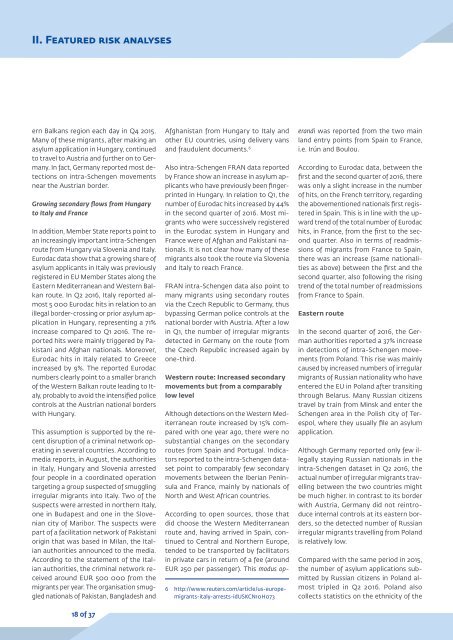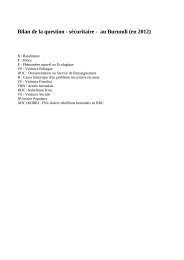Q3 Q4
g8iBkai
g8iBkai
Create successful ePaper yourself
Turn your PDF publications into a flip-book with our unique Google optimized e-Paper software.
II. Featured risk analyses<br />
ern Balkans region each day in <strong>Q4</strong> 2015.<br />
Many of these migrants, after making an<br />
asylum application in Hungary, continued<br />
to travel to Austria and further on to Germany.<br />
In fact, Germany reported most detections<br />
on intra-Schengen movements<br />
near the Austrian border.<br />
Growing secondary flows from Hungary<br />
to Italy and France<br />
In addition, Member State reports point to<br />
an increasingly important intra-Schengen<br />
route from Hungary via Slovenia and Italy.<br />
Eurodac data show that a growing share of<br />
asylum applicants in Italy was previously<br />
registered in EU Member States along the<br />
Eastern Mediterranean and Western Balkan<br />
route. In Q2 2016, Italy reported almost<br />
5 000 Eurodac hits in relation to an<br />
illegal border-crossing or prior asylum application<br />
in Hungary, representing a 71%<br />
increase compared to Q1 2016. The reported<br />
hits were mainly triggered by Pakistani<br />
and Afghan nationals. Moreover,<br />
Eurodac hits in Italy related to Greece<br />
increased by 9%. The reported Eurodac<br />
numbers clearly point to a smaller branch<br />
of the Western Balkan route leading to Italy,<br />
probably to avoid the intensified police<br />
controls at the Austrian national borders<br />
with Hungary.<br />
This assumption is supported by the recent<br />
disruption of a criminal network operating<br />
in several countries. According to<br />
media reports, in August, the authorities<br />
in Italy, Hungary and Slovenia arrested<br />
four people in a coordinated operation<br />
targeting a group suspected of smuggling<br />
irregular migrants into Italy. Two of the<br />
suspects were arrested in northern Italy,<br />
one in Budapest and one in the Slovenian<br />
city of Maribor. The suspects were<br />
part of a facilitation network of Pakistani<br />
origin that was based in Milan, the Italian<br />
authorities announced to the media.<br />
According to the statement of the Italian<br />
authorities, the criminal network received<br />
around EUR 500 000 from the<br />
migrants per year. The organisation smuggled<br />
nationals of Pakistan, Bangladesh and<br />
Afghanistan from Hungary to Italy and<br />
other EU countries, using delivery vans<br />
and fraudulent documents. 6<br />
Also intra-Schengen FRAN data reported<br />
by France show an increase in asylum applicants<br />
who have previously been fingerprinted<br />
in Hungary. In relation to Q1, the<br />
number of Eurodac hits increased by 44%<br />
in the second quarter of 2016. Most migrants<br />
who were successively registered<br />
in the Eurodac system in Hungary and<br />
France were of Afghan and Pakistani nationals.<br />
It is not clear how many of these<br />
migrants also took the route via Slovenia<br />
and Italy to reach France.<br />
FRAN intra-Schengen data also point to<br />
many migrants using secondary routes<br />
via the Czech Republic to Germany, thus<br />
bypassing German police controls at the<br />
national border with Austria. After a low<br />
in Q1, the number of irregular migrants<br />
detected in Germany on the route from<br />
the Czech Republic increased again by<br />
one-third.<br />
Western route: Increased secondary<br />
movements but from a comparably<br />
low level<br />
Although detections on the Western Mediterranean<br />
route increased by 15% compared<br />
with one year ago, there were no<br />
substantial changes on the secondary<br />
routes from Spain and Portugal. Indicators<br />
reported to the intra-Schengen dataset<br />
point to comparably few secondary<br />
movements between the Iberian Peninsula<br />
and France, mainly by nationals of<br />
North and West African countries.<br />
According to open sources, those that<br />
did choose the Western Mediterranean<br />
route and, having arrived in Spain, continued<br />
to Central and Northern Europe,<br />
tended to be transported by facilitators<br />
in private cars in return of a fee (around<br />
EUR 250 per passenger). This modus op-<br />
6 http://www.reuters.com/article/us-europemigrants-italy-arrests-idUSKCN10H073<br />
erandi was reported from the two main<br />
land entry points from Spain to France,<br />
i.e. Irún and Boulou.<br />
According to Eurodac data, between the<br />
first and the second quarter of 2016, there<br />
was only a slight increase in the number<br />
of hits, on the French territory, regarding<br />
the abovementioned nationals first registered<br />
in Spain. This is in line with the upward<br />
trend of the total number of Eurodac<br />
hits, in France, from the first to the second<br />
quarter. Also in terms of readmissions<br />
of migrants from France to Spain,<br />
there was an increase (same nationalities<br />
as above) between the first and the<br />
second quarter, also following the rising<br />
trend of the total number of readmissions<br />
from France to Spain.<br />
Eastern route<br />
In the second quarter of 2016, the German<br />
authorities reported a 37% increase<br />
in detections of intra-Schengen movements<br />
from Poland. This rise was mainly<br />
caused by increased numbers of irregular<br />
migrants of Russian nationality who have<br />
entered the EU in Poland after transiting<br />
through Belarus. Many Russian citizens<br />
travel by train from Minsk and enter the<br />
Schengen area in the Polish city of Terespol,<br />
where they usually file an asylum<br />
application.<br />
Although Germany reported only few illegally<br />
staying Russian nationals in the<br />
intra-Schengen dataset in Q2 2016, the<br />
actual number of irregular migrants travelling<br />
between the two countries might<br />
be much higher. In contrast to its border<br />
with Austria, Germany did not reintroduce<br />
internal controls at its eastern borders,<br />
so the detected number of Russian<br />
irregular migrants travelling from Poland<br />
is relatively low.<br />
Compared with the same period in 2015,<br />
the number of asylum applications submitted<br />
by Russian citizens in Poland almost<br />
tripled in Q2 2016. Poland also<br />
collects statistics on the ethnicity of the<br />
18 of 37






